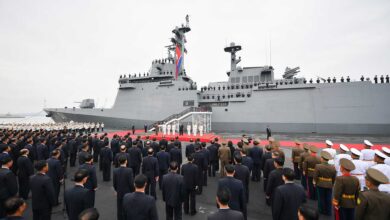In September 1998, on his way back from an inspection of frontline military units, Kim Jong Il visited the Patriotic Martyrs Cemetery on the outskirts of Pyongyang.
He toured the tombs one by one, looking in particular at the photographic images carved on the tombstones.
“Here I can see all the unforgettable people. It seems that every one of them has come back to life. Their photographs look good,” Kim Jong Il commented with satisfaction.
Saying that it might take a long time but he would see all the martyrs’ images, he inspected all the remaining tombs which were arranged in tiers. In front of one tomb he recollected that the man had contributed a great deal to strengthening and developing the revolutionary armed forces, and seeing another, praised him for his great service to construction, especially in the capital city.
He stopped for a while before each tomb as if he was having a personal conversation with the martyrs.
He said in a hoarse voice that they had been boundlessly faithful to the Party and the revolution and it was heartbreaking to think that they had died so early when still in their prime.
He continued examining other photographs. Dusk fell, but he was reluctant to leave. He examined them with the help of his car’s headlights.
He went down the stairs to leave and stopped again, saying, “Today, having looked round the Patriotic Martyrs Cemetery, I regret to see that there are some martyrs missing. All the martyrs who lived an honourable life for the Party and the leader should be buried in this cemetery.”
He then mentioned the names of some officials who had been faithful to the revolution to the last moment of their lives, and advised that their remains be moved to the cemetery and tombstones with their photographs carved on them, erected. He stressed that the Party and the people would always remember the great achievements they had made for the independence and reunification of the country and socialist construction.
On his return from the cemetery, he met some officials and said pleasantly that the cemetery, with the martyrs’ photographs carved on the tombstones, had taken on a new appearance.
Then he asked, “Have you all been there?”
The officials were struck dumb at this question.
“Well, we were too busy …” said one of them, trailing off.
Kim Jong Il’s smile faded. He reproved them for not visiting the cemetery even after being informed that photographic images of the martyrs had been carved on the tombstones, and accused them of lacking a sense of revolutionary obligation and comradely love. He pointed out that they should never forget the patriotic martyrs who had devoted themselves to the liberation of the country, socialist construction and national reunification.
He went on:
Korean revolutionaries value their revolutionary obligations more than their lives. We achieved single-hearted unity and created the glorious history of the Korean revolution on the strength of this noble sense of moral obligation. Our Party is strong and our revolution is invincible because we have inherited and developed the brilliant tradition of revolutionary obligations created by President Kim Il Sung.
By now, the officials were looking embarrassed. He said:
“All of you should visit the Patriotic Martyrs Cemetery. Your comrades there would be happy to see you.”

